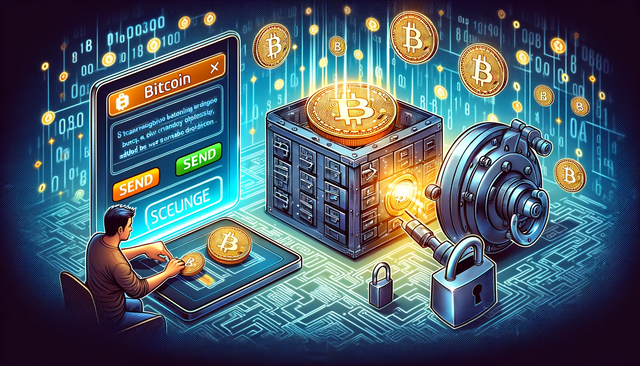Hey Steemians,
Ready for another dive into "BlockBasics," with me? Today, we're tackling a big one: Immutable Ledgers. Don't worry, we're in this together – I'm figuring this out just like you are!
So, immutable ledgers – sounds fancy, right? But it's actually just a super secure way of recording stuff on blockchain. Imagine writing something in pen that no one can erase – that's what we're talking about. It's key for keeping our digital info safe, and honestly, it's pretty cool once you start to get it.
I'm here to break this down and make it as chill and clear as possible. We're all learning here, so feel free to jump in with your thoughts or questions at any point. Sharing is caring, right? 😁
Let's kick this off and see why these immutable ledgers are such a big deal in blockchain. I'm ready if you are – let's get started!
Summary
- Immutability for Beginners
- Why Immutability Rocks ?
- Learning Through Examples
- Challenges and Limitations
- Concluding Thoughts: A Learning Journey
1. Immutability for Beginners

Alright, let's start with the basics: what's up with this big word, immutability? Think of it like writing with a permanent marker. Once you've written something, you can't just rub it out. In the blockchain world, it's kind of the same deal. When data gets added to the blockchain, it's there for good. No take-backs, no edits. It's like carving into stone, but digitally!
Here's a fun way to see it: imagine you're sending a postcard to a friend. Once it's sent, you can't just grab it back from the mailbox and change what you wrote. That's how blockchain records data. Every transaction, every bit of info, once it's on the blockchain, it's set in stone (or, well, in code!).
2. Why Immutability Rocks
Now, you might be wondering, why is this so cool? As I've been learning, I realized immutability is like the superhero of blockchain security. It's what makes the whole system super trustworthy. You see, when data can't be changed or deleted, it means everything is transparent and traceable. No sneaky business possible!
This is huge, especially when we're talking about stuff like financial transactions. Knowing that once something is recorded on the blockchain it can't be tampered with – that's peace of mind right there. It's like having a super secure diary that no one else can write in or tear pages from.
As I've been diving into all this, it's hit me how this one feature – immutability – is a game-changer. It's not just about keeping records; it's about building a whole system where you can truly trust what you see. And that's kind of amazing, right?
3. Learning Through Examples

Let's put this immutability thing into a real-life scenario. Think about a Bitcoin transaction. Imagine you're sending some Bitcoin to a friend. Once you hit that send button and the transaction gets added to the blockchain, it's like locking your message in a super secure vault. No one can go in and change the amount you sent or the recipient. It's all locked in, safe and sound.
Transaction Confirmation and Immutability:
When you conduct a transaction, such as sending Bitcoin, the transaction goes through a confirmation process. Once confirmed, it becomes immutable, meaning it cannot be altered or reversed by anyone on the network. This ensures that the transaction details remain permanent and secure on the blockchain. Think of it like a sealed deal – once your transaction is confirmed, it's as good as set in stone【source】.The Process of Achieving Immutability:
Immutability doesn't happen instantly. In blockchain, a transaction becomes more irreversible as more blocks are added to the chain after it. Theoretically, it's possible for miners to switch to an alternative chain, invalidating your transaction. However, as more transactions follow yours, changing the chain becomes increasingly impractical and resource-intensive, thus solidifying your transaction's place in the blockchain history【source】.Timeframe for Irreversibility:
On the Bitcoin network, a transaction is considered probabilistically irreversible after about 60 minutes or six blocks. This timeframe is a general agreement within the Bitcoin community, representing a balance between speed and security【source】.
These aspects highlight how blockchain, through its design and community consensus, achieves a high degree of immutability, making it a reliable and secure platform for transactions like Bitcoin.
4. Challenges and Limitations
Now, let's talk about some tricky stuff. Blockchain isn't perfect, and one challenge that had me scratching my head is something called a 51% attack. This is when someone manages to control more than half of a blockchain network's computing power. It's like if someone somehow got the keys to more than half the vaults in a bank. Sounds scary, right?
But here's the cool part: the blockchain community is always on guard. They're like digital superheroes, constantly upgrading and protecting the system. There are tons of discussions on forums like Bitcointalk.org where people are always brainstorming ways to make blockchain even more secure.
I won't lie – I'm still trying to fully grasp all this. It's complex, but super fascinating. And hey, if you're feeling a bit puzzled by all this too, you're not alone. Let's figure it out together! Feel free to share any insights or resources you've found in the comments. After all, we're all here to learn from each other!
5. Concluding Thoughts: A Learning Journey
And there we have it, Steemians! We've just taken a stroll through the world of Immutable Ledgers in blockchain. For me, it's been an eye-opener – like finding a secret layer in a game that changes everything. This journey into understanding how once something's in the blockchain, it's there for good, has been both fascinating and a bit mind-boggling.
I'm super curious to hear your take on this. Got any cool insights, lingering questions, or neat resources to share? Drop them in the comments! Let's keep this learning train chugging. Remember, we're all in this together, figuring out the vast and exciting world of blockchain, one topic at a time. Can't wait to see what you all think!
Previous articles:
- BlockBasics 0.0.0 : Embarking on a Blockchain Adventure - A Developer's Fresh Perspective
- BlockBasics 1.1.1: What is Blockchain? - A Beginner's Guide
- BlockBasics 1.1.2: The History of Blockchain: From Satoshi to Global Adoption
- BlockBasics 1.1.3: Blockchain Myths Debunked
- BlockBasics 1.2.1: How Blocks and Chains Work Together
- BlockBasics 1.2.2: Inside a Block - Data Structure in Blockchain
😊 Join the Conversation:
What's your take on the blockchain revolution? 🚀 Have you encountered any applications of blockchain in your life or work that surprised you? Share your stories in the comments below! 👇
❤️ Support the Journey:
Every upvote 👍, comment 💬, and resteem 🔁 not only fuels my passion for writing but also supports the creation of more educational content. Let's demystify the tech together!